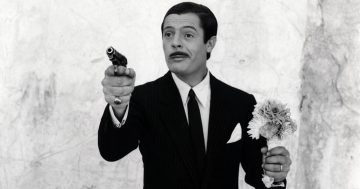Screwball Comedy
Film Art
We could make this publication thanks to small donations. How is 3 minutos de arte supported?
Screwball Comedy
Screwball comedy is a subgenre of comedy that marked a milestone in the history of cinema. It is the one that includes films that we would vulgarly define as “films where the most absurd and crazy things happen to eccentric and delirious characters in a short time and at full speed, and which become more and more entangled, to arrive unfailingly to a happy ending where everything is resolved and love triumphs.”
A screwball in baseball is a ball that has a twisted movement, like a corkscrew. By extension, this name is used to define strange behavior that is twisted and funny at the same time. It is a comedy with a twisted plot, full of tangles and unexpected turns.
Screwball comedy is a synonym for the great era of Hollywood comedy. It extended between 1934 and the early 1940s. (Some consider the initial milestone to be Frank Capra’s It Happened One Night; others argue that it is Howard Hawks’ The Comedy of Life.) Of course, the period we are talking about is its peak, but we still see screwball comedies even today.
In the midst of the economic crisis of the Great Depression, in the United States, humor, hope, escape, and happy endings were necessary. There was a tremendous crisis affecting the population, and it was also killing the film industry. That is why it was necessary to give the population a moment of distraction, humor, and an optimistic message. And at the same time, the theaters needed to be filled again.
These are the fundamental ingredients of this type of comedy (although we do not always find them all in a single film):
- An ingenious plot triggered by some absurd situation or event, with funny and delirious situations that intertwine and make the story become more and more entangled until the final solution.
- In the midst of the economic crisis that the United States is going through, the stories always involve the upper class and their sophisticated lives. And, coincidentally, the rich discover that happiness is not in money but in love and noble values. So viewers escape for a while from their economic situation and enjoy the delights of the aristocracy, but return to their world with the message that “it is not money that makes happiness, but love.”
- There is at the same time a subtle satire (humorous criticism) of the upper classes. The spectators then laugh a little at that world to which they cannot gain access.
- The dialogues are sharp and full of wit and humor. It is only recently that films have sound and verbal humor can be exploited. Moreover, these dialogues go at full speed (sometimes the characters voices overlap), which gives the film an even greater rhythm.
- Chaos is always resolved. The endings are happy and funny, instilling the hope the viewer needs.
- The role of women becomes important. The protagonist of the screwball comedy is the model of the intelligent, rebellious, not at all submissive, sharp-tongued, courageous, non-conformist woman. (To many, it reminds them of Shakespeare’s heroines.) This ideal woman is often the one who generates the conflict and also the one who resolves it.
- And finally, the year when the boom of this type of comedies began, the Hays Code came into force. It was a very strict censorship code that began to govern film production. (We recommend the article dedicated to this topic, the link is below). To avoid sanctions, directors and screenwriters had to sharpen their creativity, and as a result, there are really ingenious resources based on humor, absurdity, and nonsense, to show situations or say things that in a serious plot would not be admitted.
Image: Katherine Hepburn, Cary Grant and the leopard Baby in Bringing Up Baby (Howard Hawks, 1938)
Representative films:
It Happened One Night (Frank Capra, 1934)
Twentieth Century (Howard Hawks, 1934)
My Man Godfrey (Gregory La Cava, 1936)
Mr. Deeds Goes to Town (Frank Capra, 1936)
The Awful Truth (Leo McCarey, 1937)
Bringing Up Baby (Howard Hawks, 1938)
You Can’t Take It with You (Frank Capra, 1938)
Bluebeard’s Eighth Wife (Ernst Lubitsch, 1938)
Holiday (George Cukor, 1938)
Ninotchka (Ernst Lubitsch, 1939)
His Girl Friday (Howard Hawks, 1940)
El bazar de las sorpresas (Ernst Lubitsch, 1940)
The Philadelphia Story (George Cukor, 1940)
The Shop Around the Corner (Ernst Lubitsch, 1940)
Ball of fire (Howard Hawks, 1941)
The Lady Eve (Preston Sturges, 1941)
To Be or Not to Be (Ernst Lubitsch, 1942)
Heaven Can Wait (Ernst Lubitsch, 1943)
Adam’s Rib (George Cukor, 1949)
Recommended links:
The Golden Age of Hollywood (Classic Hollywood Cinema).
The First Comedy Film of the History of Cinema.
Charles Chaplin and his character Charlot.
Georges Méliès and the Magic of the Cinema.
The Best American Movies in History according to the American Film Institute.
You can also find more material using the search engine.




0 Comments